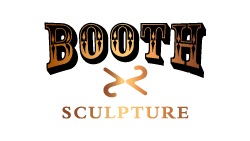The Lost-Wax Method: From Clay to Bronze
Creating a bronze sculpture using the lost-wax method is a complex, multi-step process that requires precision and skill. Bob Booth, a master sculptor, employs this ancient technique to bring his dynamic Western-themed sculptures to life. Here is a detailed explanation of each step in the process, from the initial clay model to the finished bronze piece ready for collectors.
1. Concept and Design
The journey begins with an idea. Bob Booth draws inspiration from his deep connection to the Western tradition, often sketching his concepts and envisioning the final piece in great detail. Once the design is clear, he moves on to creating a clay model.
2. Creating the Clay Model
Using oil-based clay, Booth sculpts the initial model by hand. This stage involves shaping and detailing the sculpture to match his vision. Booth uses various tools to refine textures and add intricate details, preferring to work en plein air to capture the true essence of his subjects. The clay model serves as the prototype for the entire casting process.
3. Making the Mold
Once the clay model is complete, it is used to create a mold. This is usually done in two parts to capture every detail of the original sculpture. The mold is made from a flexible material, such as silicone rubber, supported by a hard outer shell made of plaster or fiberglass. The clay model is coated with the flexible material, which is then reinforced with the hard shell.
4. Creating the Wax Model
After the mold hardens, it is opened, and the clay model is removed. Molten wax is then poured into the mold to create a hollow wax replica of the original sculpture. This wax model captures all the fine details of the clay model. Once the wax hardens, the mold is carefully removed, leaving a precise wax duplicate of the original sculpture.
5. Chasing the Wax
The wax model often has seams or imperfections that need to be corrected. This process, known as chasing, involves smoothing out these flaws and refining the details. Booth meticulously works on the wax model, ensuring it perfectly matches the original clay sculpture.
6. Adding the Sprues and Gates
Next, wax rods called sprues and gates are attached to the wax model. These serve as channels for the molten bronze to flow into the mold and for the air to escape during casting. The placement of these rods is crucial for ensuring a successful casting.
7. Creating the Ceramic Shell
The wax model, with its sprues and gates, is then dipped into a ceramic slurry and coated with fine sand. This process is repeated several times to build up a thick, heat-resistant ceramic shell around the wax model. Each layer is allowed to dry before the next is applied.
8. Wax Burnout
Once the ceramic shell is complete and fully dried, it is placed in a kiln and heated. The heat melts and burns out the wax from inside the ceramic shell, leaving a hollow cavity that exactly matches the original wax model. This is why the process is called the lost-wax method.
9. Pouring the Bronze
With the wax gone, the ceramic shell is ready for the molten bronze. The shell is heated again to prevent it from cracking when the hot bronze is poured. Molten bronze, an alloy of copper and tin, is then poured into the ceramic shell through the sprues and gates. The bronze fills the cavity, taking the shape of the original wax model.
10. Breaking the Ceramic Shell
Once the bronze cools and solidifies, the ceramic shell is broken away, revealing the rough bronze sculpture. The sprues and gates, now also in bronze, are cut off and the sculpture is cleaned.
11. Welding and Metal Chasing
The bronze is cast in multiple pieces. These pieces need to be welded together like a puzzle. The welding must be done with precision to ensure the final sculpture looks seamless. After welding, the bronze sculpture is refined and detailed in a process called metal chasing. Any imperfections are corrected, and the surface is smoothed and polished. any ropes or reigns are fabricated by hand at that time.
12. Applying the Patina
The final step is applying a patina, a surface finish that enhances the sculpture's appearance and protects the bronze. Patinas are created using chemical treatments that react with the bronze to produce various colors and textures. Booth often uses heat to accelerate this process, creating unique finishes for each sculpture.
13. Final Touches and Mounting
The completed bronze sculpture is given any final touches it may need, ensuring it meets Booth's high standards. The piece may be mounted on a base, signed, and numbered, ready to be delivered to collectors. Booth offers custom-tooled leather bases with high-end woods, adding an extra level of craftsmanship and uniqueness to each sculpture. These bases not only enhance the aesthetic appeal but also ensure the sculpture is securely mounted and presented beautifully.
For a deeper look into Bob Booth’s artistry and to explore his stunning collection of Western-themed bronze sculptures in person, visit Gallerio Grande in South Fork Colorado. Each piece is a testament to the meticulous craftsmanship and dedication required to create timeless works of art that capture the spirit of the American West.
